Author(s): <p>Venkata Naga Sai Kiran Challa</p>
On the principle of AUIs, user profiling and user modeling are critical processes that play a critical role in the decision-making process as regards adapting the same to accommodate different users. The first step entails an extensive gathering of data that helps drive the understanding of users' behavior and intentions. Three primary data sources are utilized in this process: This form of big data includes interaction, contextual, and precisely defined user-provided data.
Interaction data includes the user's activities and the other related happenings within the framework of the given system. This con- cerns click stream data, which are records of the path or sequence of clicks chosen by a user while going through the interface. Clickstream data is essential because it reflects the history of the user's click-through, who accessed the page or feature, and if it was viewed first or second. For example, clickstream data, as described by Bucklin and Sismeiro can inform about users' decision-making processes and reveal specific patterns of user behaviors that are beneficial for developing AU Interfaces [1].
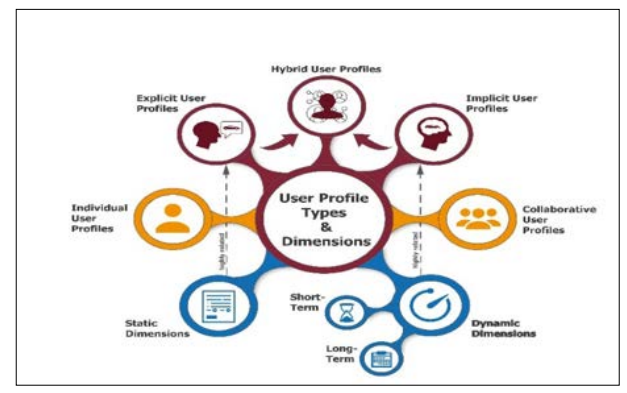
Figure 1: User Definition and Profiling
Interaction context concerns the characteristics of the environment in which the interaction is taking place; for example, the type of device being used, the physical location of the interaction, or the time of access. Such data is vital primarily to understand the background of specific actions taken by the users and the interface adjustments necessary to suit them. For example, knowing if the user is on a mobile or a computer terminal substantially determines what is provided to them regarding interface design. In the study by Smith and Davenport, the authors stressed the significance of the contextual data. They pointed out that while using location- based services such as GPS, users can obtain more buoyant and valuable information depending on the user's position.
Implicit user data includes information provided willingly by the users and includes the choices, settings, and feedback about the system. It can be obtained by communicative activities performed during a particular service, such as when people fill in the forms or answer surveys. Explicit data are essential in this case as they represent the user's well-calculated stands and preferences, hence the high percentage of personalization possible. In a paper by Dinev and Hart, the authors explained that explicit user-provided data integrated with implicit data enhances the accuracy and ef- ficiency of personal services [2].
Interaction, context, and, last but not least, the explicit input from the user defines the fundamental guidelines of user profil- ing and modeling. Specifically, any data source provides specific information, which creates a holistic perception of the user. This coordinated approach helps design and implement the reactive user interface, which can meet different users' different needs, thus improving satisfaction and the overall level of user interest. Adaptive user interfaces incorporating elaborate data collection techniques and analysis of users' profiles and models will be a steadily more relevant factor in the increasingly digital world.
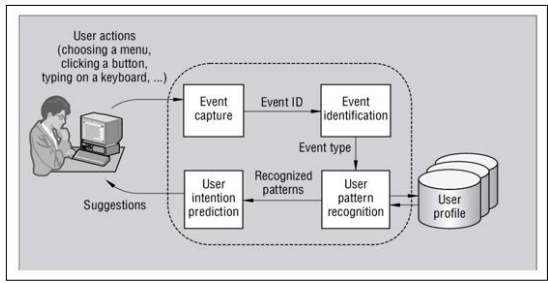
Figure 2: A Personalized Adaptive User Interface
Adequate data storage and management are challenging due to the sheer amount of user data gathered when it comes to realiz- ing an adaptive user interface. This process uses databases, data warehouses, and real-time data processing frameworks.
Finding the essence of the data is an essential step within the framework of modeling for adaptive interfaces. It aims to deter- mine different measures of users' characteristics and then describe and prescribe the resulting profile. These features are generally classified as behavioral, contextual, and demographic.
Behavioral features refer to a user's behaviors in an interface and how they tend to perform activities. Such as the number of visits, the time spent on the site, and the pattern of the clicks. To be more specific, such behaviors as visit frequency and their specific click paths can be recognized as user interests. In the view of Chittaro and Montanari, behavioral data is valuable in identifying user preferences and behavior, hence helping in the design or devel- opment of adaptive interfaces [3]. Thus, such data can be used to align content and functions to the expectations of their users and enhance the experience.
Contextual data, in this case, can be defined as the environmental circumstances that define the interaction of the users with the devices, place, and time. To refine this consideration and define where the changes are necessary, such information is essential to improve the interface in response to various contexts of use. For instance, the user using the service from a mobile gadget may need a different layout format than a PC. Dey and Abowd believe that contextual information is the key to augmenting the relevance and usefulness of adaptive systems, which are used to gain insights into the situational context of the user's interactions [4]
Some of the demographic characteristics are age, gender, and any other characteristics that define the nature of the users and their ten- dencies. These features are frequently obtained from registration data or derived from the users' behavior. In their work, Nguyen et al. specifically stated that demographic information plays a factor in the user experience, stating that age and gender may affect the preferences and interactions of users [5]. Adding demographic data to the user models allows for designing interfaces that meet the unsaid needs of minority users.
In the context of best practices for creating a good user model, social behavior, context, and demographic data must all be con- sidered and extracted well in feature extraction. These features can contribute to creating adaptive user interfaces that are highly specific to users since they address their specific requirements, which will improve the usefulness of applications with interfaces designed in this way and increase user satisfaction.
User Representation
In adaptive user interfaces, user representation is one of the es- sential features that help gain insights about users and model the user behavior appropriately. Regarding the VSM, there is a rec- ognizable approach to representing users, which may be referred to as user modeling. In the VSM methodology, users are depicted using vectors within the n-dimensional space in which each vector entity corresponds to a particular feature obtained from the user data sources. The primary technique used is the ability to model the distance or similarities between vectors and perform user profile comparisons. VSM was first proposed by Salton, Wong, and Yang in 1975 as an appropriate model for information retrieval and outlining the complexity of the structures. Employing the VSM, adaptive systems establish and operationalize higher-order data, embodying enhanced user interfaces. However, in cases where it is appropriate to describe the user actions’ randomness and variability, probability models are used. These models include the Bayesian networks and the Hidden Markov Models (HMM), which depict the users’ state and change probability. For example, HMM can be applied to sequences of users’ actions and forecast further behaviors using observed patterns. Adaptive systems and probabilistic models are discussed by Ghahramani especially in classifiers that employ incomplete and noisy values [6]. There are many applications of probabilistic models, especially in cases where the behavior of users changes and is dependent on context since they will be able to make predictions more easily.

Figure 3: Hidden Markov Model (HMM) structure
User segmentation is the division of users into several groups based on their characteristics and activity. Often, clustering algorithms are used for such a task. For example, K-means groups the users into k clusters by using feature similarities with the objective of reducing the variance of each cluster. This is common and efficient in han- dling most problems and is commonly used in adaptive interfaces. MacQueen further showed the efficiency of K means for clustering problems by noting that it is easy to implement [7].
Another clustering algorithm is DBSCAN (Density-Based Spatial Clustering of Applications with Noise): it finds the cluster based on the density of the points. It helps find clusters of arbitrary shapes and deal with noise. Ester et al. proposed DBSCAN in 1996, proving that the devised method for clustering is superior to most existing methods in terms of its ability to find informative patterns in big data.
Aside from clustering, latent class analysis (LCA) is used to extract latent user groups based on interactions and contextual information. LCA assumes that more hidden classes influence the observable data while segmenting the users, thus giving the model a probabilistic nature. Collins and Lanza outline using LCA in behavioral research, which is suggested to uncover structures in large datasets. LCA can contribute to discovering subtleties of the adaptive systems’ users that are not exposed when applying clustering techniques, thus improving the capacity of the adaptive systems to focus on specific segments of users [8].
In adaptive user interfaces, machine learning algorithms process user data and provide improved and recommended features. They can be classified into three broad types: supervised learning algorithms, unsupervised learning algorithms, and reinforcement learning al- gorithms. All three have different methods and uses.
Supervised learning is learning from a set of data with known outcomes for given inputs. It is generally used for classification and regression to assign different weights to different instances in the training set.
Unsupervised learning refers to working with data that does not have predefined labels. It can be used in tasks like clustering and reducing the data dimensions.
Reinforcement learning is a learning process in which an agent faces an environment and makes decisions by receiving feedback as a reward for its actions. It is more effective in environments that are constantly changing as it picks up new interaction pat- terns with time.

Figure 4: Q-Learning vs. Deep Q-Learning
The described use of the supervised, unsupervised, and rein- forcement learning algorithms helps enhance the user interface's adaptation. These ML techniques allow applications to learn a user's behavior and respond, reason, and learn the user's actions in real time, thus improving the service quality.
Dynamic adaptations in UIs include several strategies devoted to adapting the content, layout, and functionality regarding the information concerning the user. These are achieved to ensure that people use the phone in a tailored and effective manner.
Recommendation systems are very essential in creating personal- ized content for the users. These systems employ collaborative filtering techniques, either user-based or item-based. User-based CF identifies similar users and then recommends items that simi- lar users prefer. While the former suggests to a user item similar to what he/she liked in the past, the latter filters items based on comparing them to a particular item. Konstan et al. explained that collaborative filtering was suitable for recommending content by observing users' behavior and preferences to increase user satisfaction and value [14].
Another type of filtering, content-based filtering, suggests items based on the properties of items the user has expressed an interest in. It is aimed at assessing the objects' features instead of the users. This hybrid approach integrates the features of both the collabora- tive and content-based methods, whereby recommendations are produced using the best aspects of the two systems, thus improving their efficiency. Burke said about hybrid recommendation systems that such systems enhanced the reliability of recommendations and their variety when using more than one filter [15].
Personalized search enhances the search results depending on the user's previous search story of the user making. Learning to Rank (LTR) is the usual approach used to enhance the ranking of the search results per the user's expectation. Due to machine learning models, LTR algorithms employ an ordering that helps make items more relevant to the end user. Joachims also proved that with the use of LTR in(re)searching, the coherence of the obtained results can be boosted due to the learning process based on the interaction with the users' feedback and responses [16].
Adaptive design is crucial in mobile application development since different applications should work well on all devices and all sizes of screens. Responsive design, now implied by most designers to mean the creation of interfaces for multiple resolutions, is imple- mented using CSS frameworks, including Bootstrap and Tailwind CSS. These frameworks contain a small number of pre-planned constituents and grid apparatus to inform the layout based on the screens of the viewed device. Marcotte suggested that website design was shifting towards what he named responsive design, which helped to make the websites qualitative and responsive in terms of accessibility and usability on different devices.
Load time optimization refers to the toggling of UI elements based on the user's context and filtering of UI components that should not be rendered on the page the first time the page is loaded. This means that some low-priority resources are loaded only when they are required and not at the point of time when a page is opened, which in turn enhances the speed of page loading and, in turn, overall site performance. Conditional rendering adapts the components that will be shown to the application user depending on the determined context, which can be the type of the device being used, or the user's preferences. In the article, Grigoras et al. mentioned the advantages of dynamic component loading to show how this or that strategy affects the optimization of the performance and the enhancement of the user experience [17].
Feature flags are also called feature toggles because they help to turn a feature on and off without any need to release a new code. This mechanism helps do A/B testing, slow rollout of new features, and rollback of features if anything goes wrong. Products such as Launch Darkly contain strategies for properly using feature toggles. In their paper, Rahman et al. described the adoption of feature toggles when applied to software development, with the main concepts of continuous integration and delivery, decreasing the risk of deployment, and increasing the level of agility.
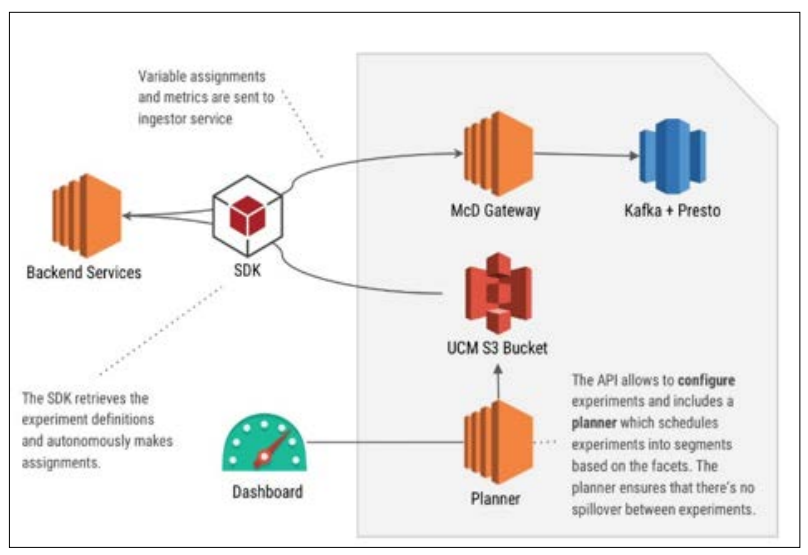
Figure 5: Feature Toggles and A/B Testing SDK
The contextual arrangements of the actions and the menu options vary according to the user's specialty and the task's current context. This adaptation makes it easier to organize tasks and enhances operational efficiency for some outcomes since the user is shown how this situation could turn out. For instance, while new control- lers may observe basic options, advanced ones are available to proficient controllers. Contextual adaptation can lead to a mas- sive improvement in usability, resulting in an overall better user experience. Johnson et al. included a study about the applicability of contextual menus in offering the stimuli of augmented user interactivity, asserting their ability to decrease the user's cognitive load and offer the most appropriate choices to the user during the execution of the tasks [18].
Adjustable interface techniques refer to enhancing the user inter- face by incorporating sophisticated procedures to affect the con- tent, layout, and interactivity. Through recommendation systems, search engines that are specific to certain individuals, websites' most preferred layout, component libraries that are only loaded when needed, feature optimization options, and menus that only appear when relevant, it is possible to create user experiences that are highly specific to what the users need. These mechanisms increase users' satisfaction, engagement, and effectiveness; thus, creating adaptive interfaces has become critical in contemporary digital applications.
Adaptive user interfaces must always have an optimum system architecture since it is the linchpin of efficient, flexible, and responsive interface use. The following architecture is usually adopted, using client-side frameworks, server-side microservices, and midware.
On client-side MEAN stack technologies, which includes JavaS- cript frameworks like React, Angular, and Vue. Js are widely applied to create attractive and interactive front ends of web ap- plications. These frameworks allow the generation of single-page applications (SPA) for which only a part of the content is reloaded. This capability is necessary for adaptive interfaces, especially if they respond quickly to the users’ actions. For instance, React, Facebook, is well known for its rendering and state management functionalities for complex and interactive UIs [19]. Moreover, there are possibilities for local storage to be equipped with Lo- calStorage and IndexedDB to store preferences and to access them quickly. Cookies can be easily used for key-value storage, where the data is saved locally for the current session and can be accessed in the next session. Local storage also provides a key- value store, but for more extensive data and complex structures, there is IndexedDB, which is an asynchronous database. This local storage is quite helpful in caching preferences and the state of the user, which, in a way, boosts the application’s response time and sustains the same user experience if the internet connection is unavailable. IndexedDB is considered vital for client-side stor- age based on Gaunt asserting that IndexedDB features flexibility regarding data types and client transaction handling.
Microservices architecture is preferred on the server side for its scalability when designing the solutions. Microservices de- compose the application into smaller and independent services, which may be deployed separately, and these services interact using APIs. This modular scale ensures that maintenance can be done concurrently and that the rate of deploying the equipment is enhanced. As Lewis and Fowler noted, continuous delivery is promoted in the microservices architecture, and the applications can manage complexity and change well [20]. RESTful and GraphQL are some APIs deployed in the client-server commu- nication processes. RESTful APIs mainly adhere to the stateless and client-server model and are accessible, easy to implement, and easily scaled. GraphQL is an open-source developed by Face- book that lets clients ask for what they need instead of receiving too much or too little information. This flexibility is essential in adaptive interfaces where data that has to be retrieved is dynamic and differs depending on the users’ interaction [21].
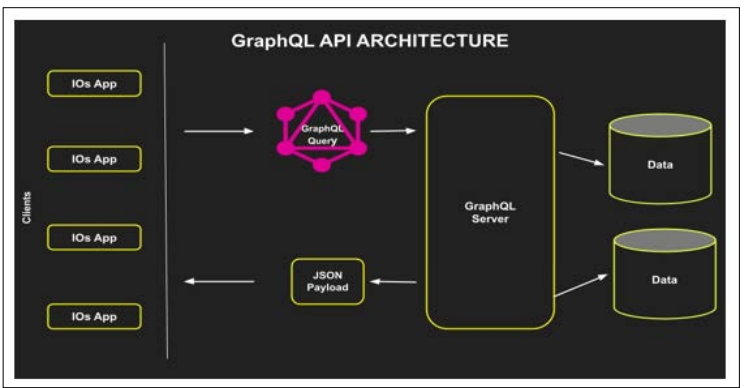
Figure 6: GraphQL vs REST
Middleware components control the interactions between the client-side and the server-side services. Versatile middle tiers may alter their operation based on the existing context and conditions to provide optimal data transmission. Systems such as Apache Kafka and RabbitMQ support message passing by having services loosely coupled and guaranteeing the passing of the message. As Kreps et al. have noted, Kafka has high throughput and low latency, thus making it appropriate when handling real-time data streams, which are fundamental in Adaptive UIs that need real- time interaction [22].
Adaptive UI design mainly involves using a client-end JavaScript framework, server-side microservices, and an adaptive middleware layer. The components above collectively result in an effective and flexible structure that can easily adjust to suit each user’s requirements.
Assessment and fine-tuning are indispensable phases in designing and implementing user interfaces that can adapt to the interacting subjects. Such processes enable the interface to always be up to its challenge of addressing the users' needs as they dynamically transform.
A/B or split testing, as it is also known, is a popular procedure that applies in assessing various versions of a user interface. This involves making two or more versions of a feature for differ- ent population groups to decide which version performs better. Specific manipulations are undertaken, often as experiments that are controlled in various ways and for which statistical tests are sought to determine whether a difference exists in the behavior of the users or the results. The authors Kohavi et al. give an ap- plication of A/B testing in web development and show that it helps to make rational data-driven decisions regarding improving the user experience [23].
Organizations like Meta often use A/B testing to optimize their features. One of the most typical examples is feature flags – the specific feature that can be allowed or blocked depending on the selected user's segments. All these flags are managed through a specific portal where characteristics such as gender, age, geo- graphical location, or actions are specified and set. In this case, the specific feature to which the user meets these criteria is activated, and its effect can be quantified. This method allows for specific targeting of the features and avoidance of certain dangers within the process since feature implementation is often done step by step with the ability to revert if problems are identified.
The reception of clients' opinions is crucial to evaluating custom- ers' satisfaction and discovering possible problem areas. Examples include surveys, user interviews, and feedback tools that are integrated into the application or website. Also, there are user analytical tools such as Google Analytics, which can provide detailed observations of users and their dispersion, activities, and interactions. Finstad states that one of the key objectives is the user feedback and analysis of the software product as the basis for subsequent iterations of the design process and its alignment with users' expectations and requirements convenient for them.
The learning also encompasses modifying the system continuously depending on new data and interacted users. It may be accom- plished during online learning when the model's parameters are modified in parallel with the new data received. Periodic model update helps the system adjust to new users' behavior and their changing preferences. In particular, Bifet and Gavaldà touched on the subject of learning with continuous data streams, pointing to the fact that it is essential for adapting the prediction model to live data sources and keeping the model up-to-date, if necessary [24].
Evaluating and optimizing adaptive user interfaces through A/B testing, user feedback, and learning is indispensable for their success. These activities allow the interface to remain relevant to users, increasing their satisfaction level.
Traditional Interfaces
Static-modeled UIs display a structured and fixed design and are easily comprehensive because of their generality. These interfaces are developed with a set-specific idea, where the layout and op- tions are similar to every user regardless of their characteristics.
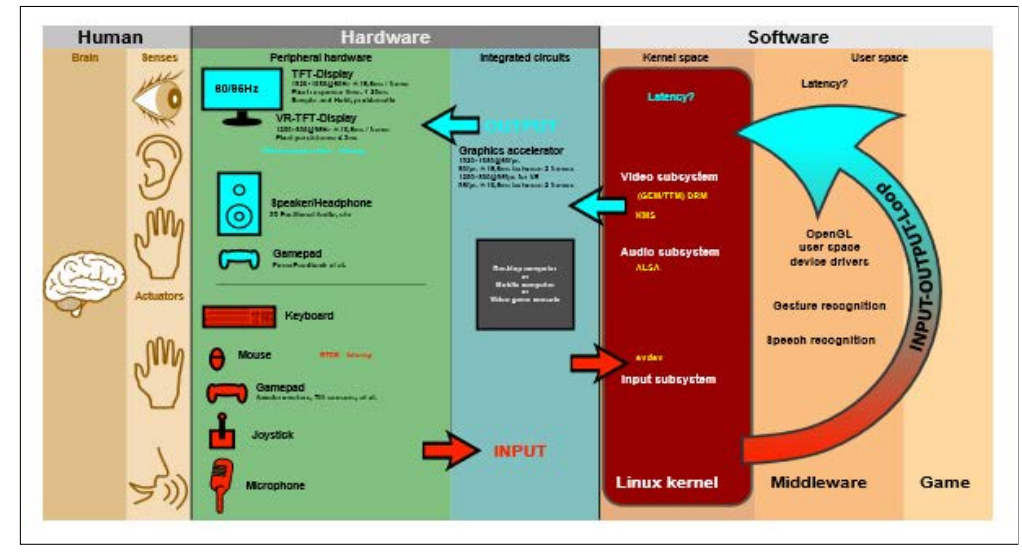
Figure 7: User interface design
Traditional interfaces are inherently unidimensional, which implies that designing them is based on a GUI's specific characteristics that do not alter its design or behavior in response to users' actions. This is an unfavorable characteristic for member station interfaces because it suggests that the site will remain stagnant and incapable of meeting the diverse and changing needs and expectations of the users after some time, according to Nielsen. This characteristic hinders differentiation and extensibility to cater to diverse user needs, hence resulting in inferior usability.
All these interfaces are generic and have been developed with an obvious intent to address an ordinary user without necessarily considering that users may differ. A generalized approach has disadvantages as it can serve the purpose without considering the individual users' requirements and sensitivity. Shneiderman and Plaisant reported that the generalized interfaces lead to a situa- tion where people claim that there is a "one-size-fits-none" since everyone cannot be appreciated or satisfied with the same user experience. While it is knowledge, it is often a broad focus that needs more detail regarding different types of users, thus bringing down the overall usability of an interface.
Traditional interfaces are mostly uniform to all users, which can be a strength or a weakness. The predictability of interfaces makes navigation easier and learning less demanding, but simultane- ously, it hinders variability to satisfy all users. Norman pointed out that while on static interfaces, predictability may become a disadvantage when applied to a complex or varied user population as it cannot recognize a user's context or profile.
Adaptive interfaces are based on collected user data, consumer feedback, and the pliability of interface elements.
Dynamic interfaces, also called adaptive ones, are defined to change according to the user's activity or their reactions to it. This attribute makes it possible to design and develop gadgets to address some basic customer requirements of the diverse users. To this end, Brusilovsky and Millán instilled the prospect of adapt- ability in such interfaces because they deliver more meaningful use experience to the ordinary user because the interfaces adapt to the users' needs in real-time [25].
An adaptive interface is rich in personalization, delivering an experience based on users' profiles and activities. Thus, such interfaces can present contents, layouts, and functions tailored to the user data that they have captured. Jameson pointed out that personalized tools increase customers and productivity based on relevant and context-adapted information and options.
Another feature of adaptive interfaces is high adaptability, which allows them to shift to a new context and suit the user's experi- ence. This helps the developers cater to the best user experience on different gadgets and occasions. Gajos et al. also showed that concepts of flexible interfaces enhanced accessibility and usability as they changed in line with the user's requirements and tasks [26]. At the same time, this flexibility prescribes the best fit for the interface to solve a given problem no matter what environ- ment it is applied to and does not limit it when it is not needed.
It could be concluded that although traditional interfaces have certain benefits, such as predictability and simplicity, a modern application cannot satisfy the heterogeneity of the contemporary user. Dynamic, personalized, and flexible interfaces make it easier for the user to use and learn since they are intelligent and function according to the user's techniques.
Organizational user interfaces (OUIs) improve user journeys by introducing adaptability. It results in better user experience and interaction as interfaces that are developed fond of and sensitive to users' preferences and habits perform better. McKinsey & Com- pany concluded in their report published in 2016 that measures towards personalization of users' digital experience could lead to a 20% improvement in satisfaction among users [27]. This makes the interface more relevant and valuable to the user and increasing the focus and usage of the interface and, thus, the AUI.
Adaptive interfaces enable the user to become more productive by completing tasks faster and with less effort. Since AUIs filter the options that are likely helpful to the users and align the most utilized paths, usage time is considerably reduced. Shneiderman and Plaisant quo cited, suggest that improvements to the UIs can boost the productivity of systems by a significant degree since the users spend reduced periods searching for the information they need and more time engaged in positive work.
Using AUI offers an opportunity to design solutions for disabled or specially needed users and make digital content more approach- able. Reducing user dependencies on specific systems outcomes in embracing different inputs, screens, and assistive technologies, and as such, AUIs can be more accommodating. For instance, Gajos et al. showed that adaptive interfaces benefited users with Motor disabilities and allowed the change of the interface as per the user's preference [26]. This flexibility guarantees optimum user interaction with the system despite the user's disabilities.
Customization can increase the utility and traffic of the site by increasing patrons' engagement and return visits. In this way, users believe an interface is designed to meet their needs and expectations. Thus, they will stay loyal to the product and not switch to other similar products. According to Accenture, 91% of consumers were willing to shop more with the relevant brands [28]. This could mean personalization is central to customers' engagement in such settings.
Complexity
Developing effective AUIs requires the most efficient algorithms and substantial user information. A disadvantage, though, is the relative difficulty of constructing and supporting such systems, which are grounded in modern AI technologies such as machine learning and data stream processing. Out of all the various facets of adaptive systems, Hearst notes that knowing the technology and the people and finding a way to balance the two may be dif- ficult [29].
The use of user data presents various questions regarding its collection and application, mainly in the aspects of privacy and data protection. Concerns can be raised about whether users know how their data is being processed and protected enough. In the EU, the General Data Protection Regulation (GDPR) indicates high standards for data privacy. As Acquisti, Brandimarte, and Loewenstein noted it is tough to balance adopting personalization and privacy for adaptive systems [30].
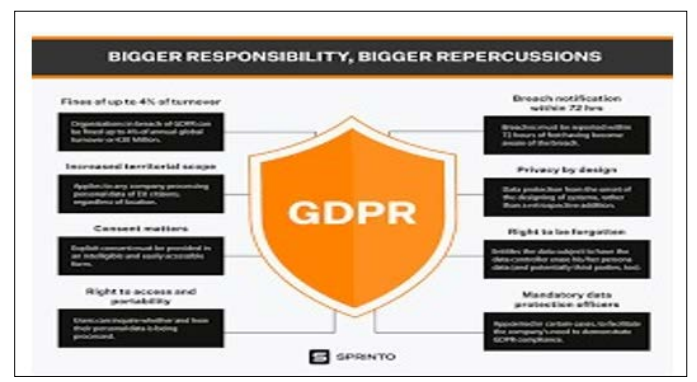
Due to real-time adaptation, AUIs demand large computational power. The capability of handling massive data on a typical daily basis can put pressure on the system and add up to expenses. In this regard, Dean and Ghemawat claim that the underlying infrastructure must be scaled and efficient to foster the success of adaptive systems [31].
People may have concerns about automated systems that self- optimize according to the users' actions. If the machine learning algorithms are black-boxed, the users are likely to get suspicious of their way of making a particular decision, or they find that the interactive interface has suddenly changed. Parasuraman and Riley noted that to build trust in the system, the users must feel they have adequate control, and anything that depicts the opposite will erode this trust [32]. Developing responsive and easy-to- understand adaptive systems is therefore essential to enhance the users' confidence.
AUIs are extensively used in different sectors where personaliza- tion application is used to improve interaction and performance.
In electronic commerce, adaptive user interfaces are used to cus- tomize products that are suggested to shoppers and search results. Sites like Amazon and eBay use artificial intelligence to study website usage and buying patterns and recommend products based on user preferences. This personalization enhances the chances of the customer purchasing, raising customer satisfaction. Smith and Linden show that Amazon's networking increases sales due to its ability to recommend the most suitable products based on information regarding the user.
Companies like Facebook and Twitter utilize AUIs to choose what to display on a user's news feed and the advertisement that should be shown to the user. These platforms analyze user en- gagements and present content that the users are interested in, optimizing engagement. For example, in the case of social sites such as Facebook, the mean filtering satisfies user needs in that it sorts posts and ads for the particular user in increasing order of the user's likelihood of interest in them based on their activity history. According to the study by Bakshy, et al. using a news feed that shows a user more of the content they like leads to more engagement and better ads [33].
AUIs adapt human interfaces and health suggestions in healthcare according to past care and personal desires. Implementations like EHRs and patient portals adjust the interface to inform and remind the patients of their health state. Blumenthal and Tavenner noted that implementing the EHRs with the manufacturing elements of an individual patient aids in increasing the patient's health status by providing the recommendations at the right time [34].
Online learning systems like Coursera and Khan Academy can change the content delivered and the layout so that they align with the student's learning style and learning achievement. Based on student performance and activity data, they provide individual learning pathways and materials. According to the authors Brusi- lovsky and Millán, adaptive educational systems increase learning effectiveness and learner satisfaction by adapting to students' learning styles [25].
Voice assistants and smart thermostats or the so-called smart home devices learn from the users and their habits. Smart home devices like the Nest thermostat are characterized by their ability to gain information regarding users' daily programs and choices to ensure efficient resource utilization. Mozer et al. have shown that adaptive home automation energy use is enhanced consid- erably with improved comfort levels through learning and user preferences [35].
Data Collection and Analysis
Decent AUIs depend on sound data capture mechanisms and sophisticated algorithms to analyze users' behaviors. This entails collecting information on users from various aspects, such as interactions, the environment, and user-provided information. Mayer-Schönberger and Cukier have noted that the idea and pos- sibility of handling Big Data constitute one of the fundamentals that enable the creation of adaptive and relevant systems [36].
There is a need to select proper machine learning algorithms to run the adaptive features optimally. Multiple algorithms are appropriate for classification, regression, clustering, and recom- mender systems. The overall success of an AUI is based on ad- equately implementing these algorithms to analyze the user data and correctly forecast preference. Domingos has mentioned that the selection of the particular algorithm affects the ability and the efficiency of the system to learn and personalize [37].
For ethical considerations, it is crucial to ensure the users know the data being collected and get their permission. An organization should use user data only with the user's approval and acknowledg- ment of the data's legal requirements by adhering to regulations such as GDPR. According to Acquisti, et al. there is a need to combine user consent and transparency so that ethical benchmarks are upheld when designing adaptive systems [30].
The concept of AUIs also implies that they should be dynamic and successively enhanced regarding user feedback and newer technologies. This involves putting in place measures that make the system incorporate constant learning and adjustment to maintain its effectiveness. McKinsey & Company further emphasizes that updating the range and depth of personalization methods pays for continually stronger user engagement and satisfaction results [27].
Adaptive user interfaces are set to become a more distinct category, with advanced technologies and users' expectations driving further developments. These include advanced Artificial Intelligence, platform compatibility, Emotional and Behavioral adaptation, and Privacy and Security issues.
Deep learning and other types of neural networks may improve the existing user modeling and personalization approaches. These technologies allow the systems to process large amounts of in- formation and search for the nonlinear relationships in the users' actions. Other advanced structures of DL, including CNNs and RNN, can improve the functionality of AUIs to deliver a personal touch. Goodfellow et al. pointed out that deep learning could significantly revolutionize aspects of AI, such as adaptive inter- faces, due to increased accuracy and capabilities of predictive computations [38]. Incorporating these advanced AI approaches will help make AUIs even smarter by enriching and making them context-sensitive, thus improving their performance.
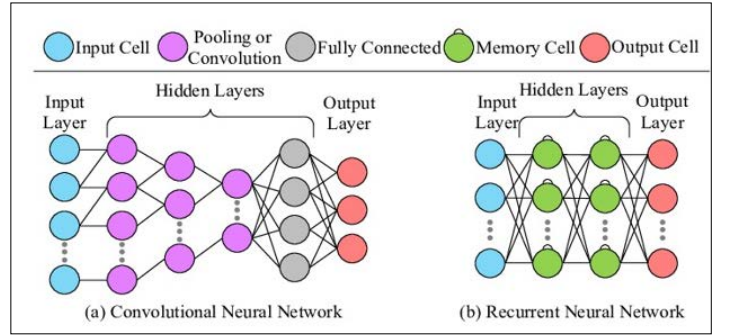
Figure 9: General structures of CNN and RNN
Continuity of adaptive experience across devices and platforms is another important research area for AUIs in future development. Customers engage with services more through personal computers, tablets, smartphones, laptops, and wearable electronics. The integra- tion of interfaces means designing interfaces that can respond to variations in the size of the displays, modes of input, and the overall surroundings of operation. The advantages of this approach include improved user interaction and satisfying design uniformity across devices. According to Nielsen, responsive web design, which aims to create web pages compatible with multiple devices, enhances the website's usability [39]. Employing the envisioned future, AUIs of the near future will utilize qualitatively improved techniques to ensure proper integration of various user interfaces, thus offering a harmonious experience.
Since emotion recognition and behavioral analysis may be easily implemented in AUIs, more natural and organic adaptations may be achieved. Emotion recognition technologies identify emotions from readers' facial expressions, voice pitch, and physiological responses, whereas behavioral analysis involves the study of pat- terns in which users engage with a system. Recognizing the ECM and BCM, AUIs can now adjust the response and the interfaces provided to the users. For instance, Picard proposed the idea of affective computing, which is acknowledgment or a move to close the gaps between human emotion and computing experiences [40]. Integrating these concepts into AUIs may improve their capacity to produce empathetically adapted responses pertinent to the user's context. This possibility can positively affect satisfaction and user engagement.
With the development of personalization, security measures are also in high demand. It is critical to devise strategies for building privacy- preserving technologies to strike a proper equilibrium between the flexibility associated with membership personalization and the security of its customers' data. Innovations like differential privacy, federated learning, and secure multi-party computation can shield personal data even when delivering personalized content. Dwork elaborated that differential privacy is the most effective means for preserving privacy in extensive data analysis [41]. Future AUIs will have to use such and other innovative methods to retain customers' confidence and adhere to higher levels of data protection control.
Future development is focused on further stabilizing AI, providing cross-platform support, allowing emotional and behavioral adjust- ments, and answering security questions. Such developments will help AUIs enhance user satisfaction, usability, and security as users' needs and expectations constantly rise.
Several adaptive interfaces were created and integrated during a stay in Meta or Facebook. A perfect example is the settings page in the facebook. The team had unrestricted user data and classifica- tion, including generic, marketing, and page users. In addition to this, the use of interaction data was also taken into account. Thus, by using this information, including geographical data and other factors, the settings page changed its design to correspond to each user's preferences. The frame was created to sort and rearrange parameters and reconstruct such tasks into a single function that had previously required two or more clicks or taps. This adaptive approach helped make the settings most frequently used for the client easily accessible, thus increasing usability.
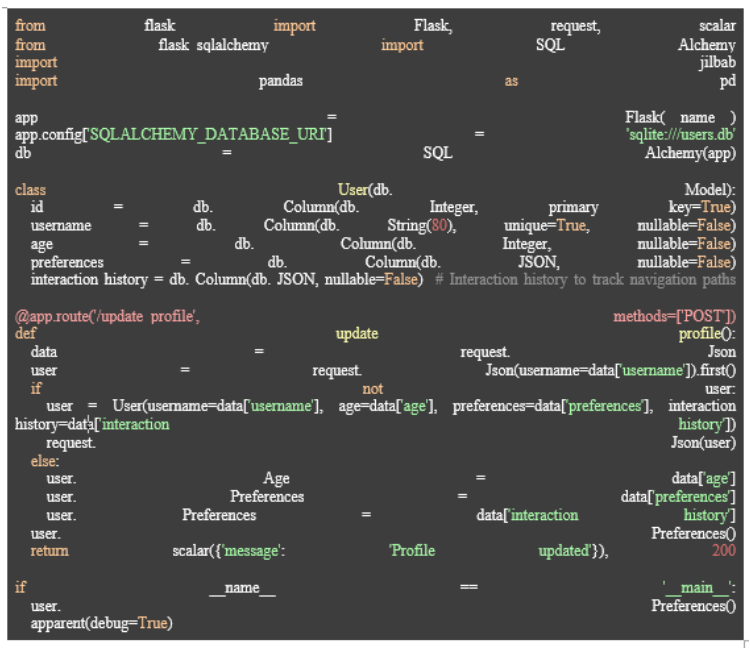
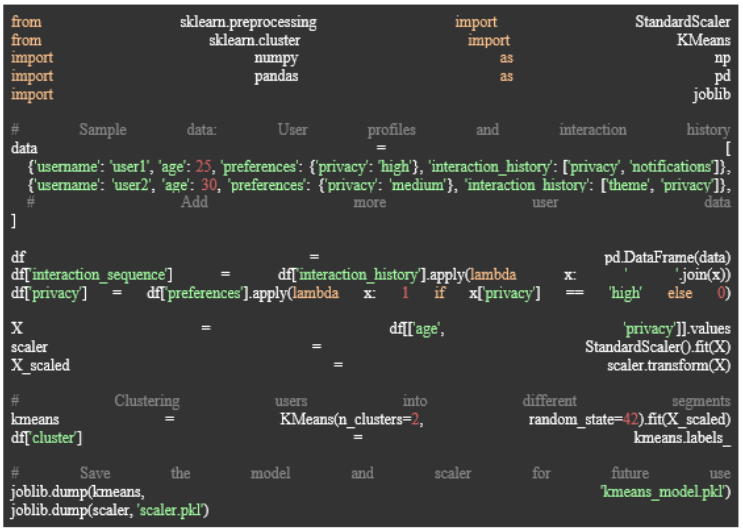
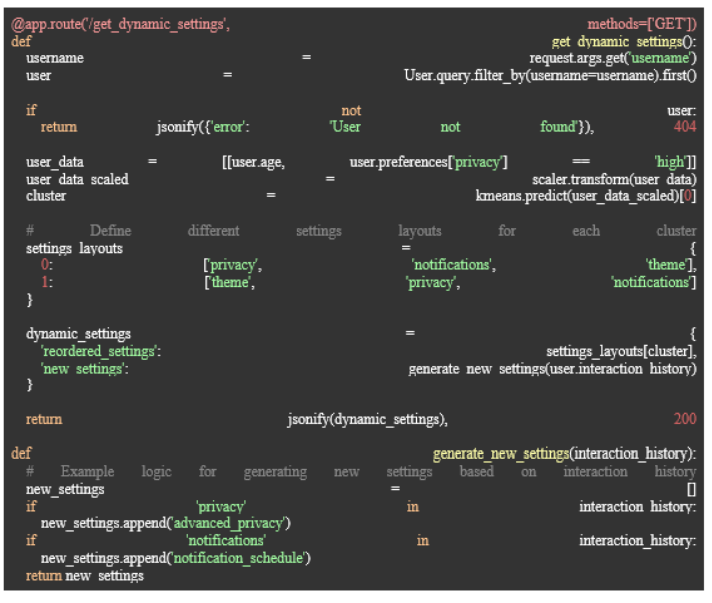
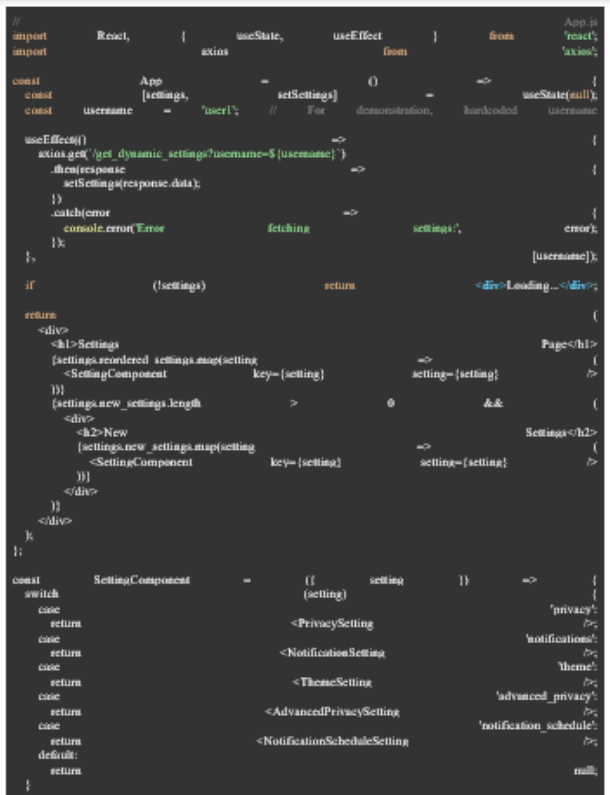
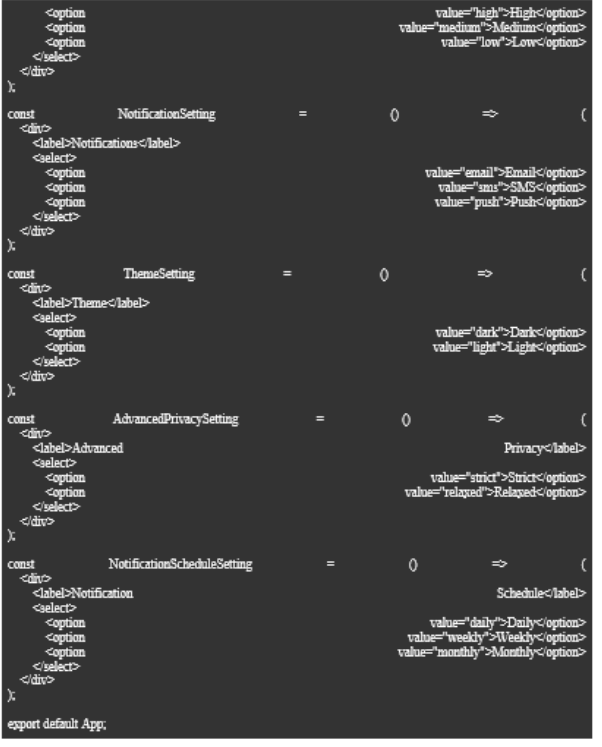
This idea can be used anywhere. For example, in automobile industry, the infotainment home screen which users can go in a tap/click can populate dynamically according to the user’s be- havior/metadata so that the drivers can find the app/option they are looking for in a second or two so that they don’t have to take their eyes off the road for long.
Integrating an IPFS (InterPlanetary File System) node cluster into adaptive user interfaces enhances the personalization of user experiences through improved data replication, availability, and security. This section explores the benefits of combining user pro- filing and modeling with a decentralized data replication system.
Adaptive user interfaces (AUIs) dynamically adjust their content and layout to match individual user preferences and behaviors. Effective AUIs rely on accurate user profiling and modeling, which require robust and reliable data storage and retrieval systems. Incorporating IPFS for data replication can significantly enhance these systems by ensuring data integrity, availability, and security.
AUIs aim to create personalized user experiences by adapting to user behaviors and preferences. This requires collecting and ana- lyzing large amounts of user data, which is used to build detailed user profiles and models.
IPFS is a decentralized storage protocol that enables peer-to-peer data sharing and storage. Its content-addressed, decentralized nature makes it an ideal solution for enhancing data replication and availability in various applications.
Data Replication with IPFS Node Cluster
Integrating IPFS into the AUI framework involves deploying an IPFS node cluster to handle data replication. This setup ensures that user data is distributed across multiple nodes, enhancing re- dundancy, availability, and security. The following steps outline the integration process:
Collect user data through various interaction points within the AUI. This data includes user preferences, behaviors, and interac- tion histories.
Store the collected user data in an IPFS node cluster. The decentral- ized nature of IPFS ensures that data is replicated across multiple nodes, providing high availability and fault tolerance.
Utilize the replicated data to build and update user profiles and models. IPFS ensures data integrity, enabling accurate and reli- able user profiling.
Implement real-time data access and retrieval mechanisms to fetch user data from the IPFS cluster. This ensures that the AUI can adapt in real-time based on the latest user data.
Use the user profiles and models to deliver a highly personal- ized user experience. The AUI can dynamically adjust content, layout, and interactions based on individual user preferences and behaviors.
Adaptive user interfaces (AUIs) significantly improve from the static user experience methods within different domains. As com- plex data gathering and analysis systems, AUIs can adapt the content, layout, and functionality of products to the user’s require- ments and patterns of use. The flexibility created in this case leads to higher satisfaction, productivity, and accessibility rates for users and, therefore, higher user retention. While the environment of today’s applications is complex, privacy is paramount, and the overall effort of implementing each AUI is understandably costly, the advantages remain apparent. Future developments for AUIs include the highly prevalent implementation of AI, cross-platform adaptability, emotional and behavioral adaptability, and privacy- shield mechanisms, making AUIs more precise and sensitive to user needs. With the advancement of technology, AUIs will play an even more crucial role in delivering user-centered experiences in the digital application. Through repeatability and analysis of these systems, developers can effectively engage and enhance the AUIs to make the digital spaces more effective [42-45].
